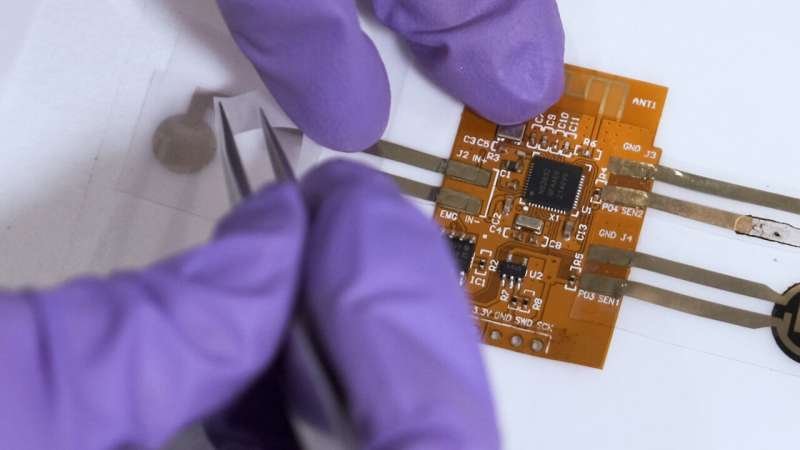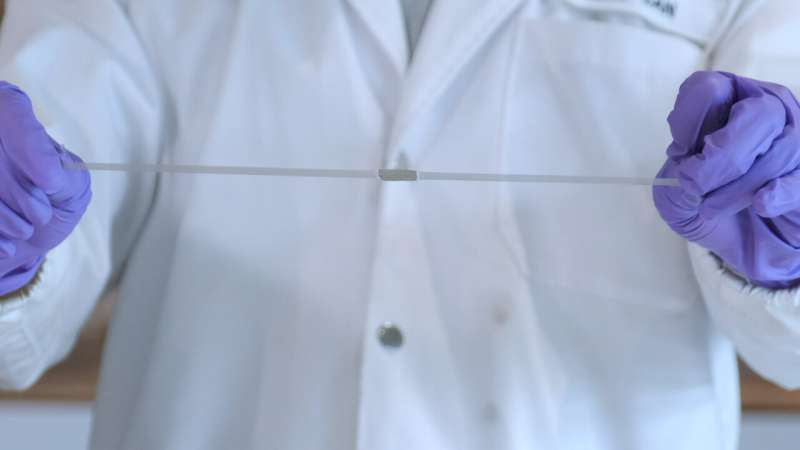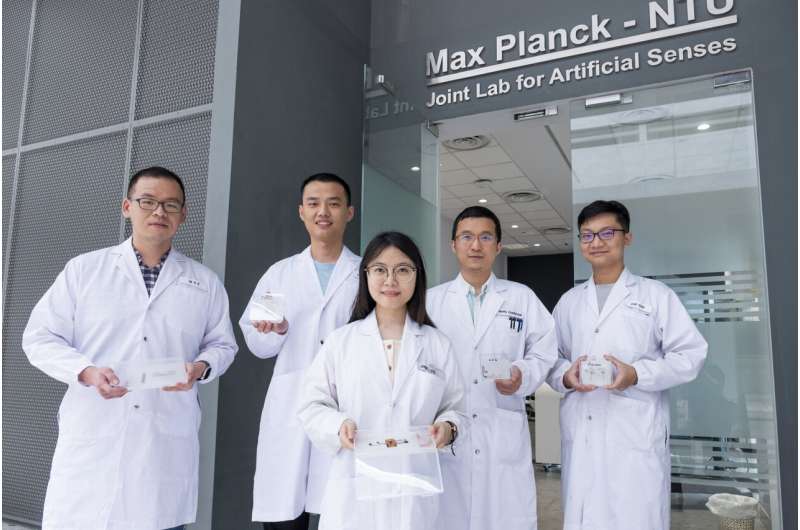‘Lego-like’ universal connector makes assembling stretchable devices a snap

An international team led by researchers from Nanyang Technological University, Singapore (NTU Singapore) has developed a universal connector to assemble stretchable devices simply and quickly, in a “Lego-like” manner.
Stretchable devices including soft robots and wearable health care devices are assembled using several different modules with different material characteristics—some soft, some rigid, and some encapsulated.
However, the commercial pastes (glue), currently used to connect the modules often either fail to transmit mechanical and electrical signals reliably when deformed or break easily.
To create a reliably functioning device, module connectors (interfaces) must be custom-built with enough strength to perform their intended tasks.
Making easily assembled stretchable devices without compromising their strength and reliability under stress has been a long-standing challenge that has limited their development.
Today the NTU-led team reports in the journal Nature their answer to this challenge—the BIND interface (biphasic, nano-dispersed interface), which makes assembly of stretchable devices simple while offering excellent mechanical and electrical performance.
Just like building structures with Lego blocks, high-performing stretchable devices can be assembled by simply pressing together any module bearing the BIND interface.
This convenient way to connect electronic modules could form the basis of assembling future stretchable devices, in which producers “plug-and-play” the components according to their designs.

Lead author of the study, Chen Xiaodong, President’s Chair Professor in Materials Science and Engineering at NTU Singapore and Scientific Director, Institute of Materials Research and Engineering, Agency for Science, Technology and Research (A*STAR), said, “Our breakthrough innovation makes it very easy to form and use a stretchable device since it works like a ‘universal connector.’ Any electronic module bearing the BIND interface can be connected simply by pressing them together for less than 10 seconds. Moreover, we do away with the cumbersome process of building customized interfaces for specific systems, which we believe will help accelerate the development of stretchable devices.”
This study is aligned with the research pillar of the University’s NTU2025 five-year strategic plan, which focuses on health and society as one area with potential for significant intellectual and societal impact.
Superior mechanical and electrical stretchability
In experiments, modules joined by the interface showed excellent performance. When subjected to stretching tests, modules were able to withstand stretching of up to seven times their original length before breaking. Moreover, the electrical transmission of modules remained robust up to 2.8 times its original length when stretched.
The BIND interface was also evaluated for its interfacial toughness using a standard Peel Adhesion Test, in which the adhesive strength between two modules is tested by pulling it apart at a constant speed at 180°. For encapsulation modules, researchers found the innovation to be 60 times tougher than conventional connectors.
Dr. Jiang Ying, research fellow at the NTU School of Materials Science & Engineering, said, “These impressive results prove that our interface can be used to build highly functional and reliable wearable devices or soft robots. For example, it can be used in high-quality wearable fitness trackers where users can stretch, gesture, and move in whichever way they are most comfortable with, without impacting the device’s ability to capture and monitor their physiological signals.”
To demonstrate the feasibility of use in real-life applications, the team built stretchable devices using the BIND interface and tested them on rat models and human skin.
When attached to rat models, recordings from the stretchable monitoring device showed reliable signal quality despite interferences on the wirings, such as touching and tugging. When stuck on human skin, the device collected high-quality electromyography (EMG) signals that measure electrical activity generated in muscles during muscle contraction and relaxation, even underwater.

How the interface works
To develop the BIND interface, researchers thermally evaporated metal (gold or silver) nanoparticles to form a robust interpenetrating nanostructure inside a soft thermoplastic commonly used in stretchable electronics (styrene-ethylene-butylene-styrene).
The resulting nanostructure provides both continuous mechanical and electrical pathways, allowing modules with BIND connections to remain robust even when deformed.
Providing his view as an expert not involved in the study, Professor Takao Someya from the Department of Electrical and Electronic Engineering at the University of Tokyo, said, “This research presents a significant achievement in developing an electrical bonding technique with excellent elasticity, avoiding stress concentration at the interconnection between modules with different rigidity, thereby reducing noise generation. Acceleration of industrial application of stretchable devices is anticipated with the establishment of an industrially scalable high-throughput manufacturing method.”
Commenting as an independent expert, Professor Shlomo Magdassi from the Institute of Chemistry at The Hebrew University of Jerusalem said, “This new universal and simple plug-and-play approach developed by Prof. Chen Xiaodong and his team is significant because it will enable the rapid combining of different components by simple pressing to form devices with various functionalities and complexities, accelerating the development of the field of stretchable electronics.”
An international patent has been filed for the innovation. For their next steps, the research team is developing a more efficient printing technology to expand the material choice and final application of this innovation, to accelerate its translation from the lab to the design and manufacturing of products.
More information:
Xiaodong Chen, A universal interface for plug-and-play assembly of stretchable devices, Nature (2023). DOI: 10.1038/s41586-022-05579-z. www.nature.com/articles/s41586-022-05579-z
Citation:
‘Lego-like’ universal connector makes assembling stretchable devices a snap (2023, February 15)
retrieved 15 February 2023
from https://techxplore.com/news/2023-02-lego-like-universal-connector-stretchable-devices.html
This document is subject to copyright. Apart from any fair dealing for the purpose of private study or research, no
part may be reproduced without the written permission. The content is provided for information purposes only.
For all the latest Technology News Click Here
For the latest news and updates, follow us on Google News.

